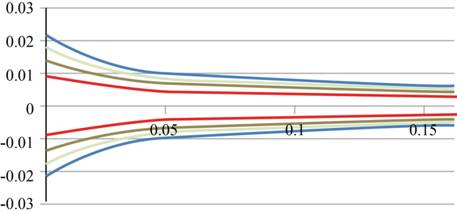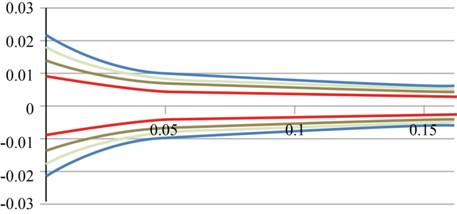
Concept explainers
(a)
The axial speeds
Answer to Problem 65EP
The axial speed
The axial speed
Explanation of Solution
Given information:
The diameter at the entrance of the nozzle is
Write the expression for axial speeds at the nozzle entrance.
Here, the volume flow rate is
Write the expression for axial speeds at the nozzle exit.
Here, the axial speed at the exit of the nozzle is
Calculation:
Substitute
Substitute
Conclusion:
The axial speeds
The axial speeds
(b)
The several streamlines in the
Answer to Problem 65EP
The following figure represents the stream lines.

Explanation of Solution
Given information:
The diameter at the entrance of the nozzle is
Write the expression for axial speeds at the nozzle entrance.
Here, the volume flow rate is
Write the expression for axial speeds at the nozzle exit.
Here, the axial speed at the exit of the nozzle is
Write the expression for stream function of the flow filed.
Here, the stream function of the flow field is
Calculation:
Substitute
Substitute
Substitute
Substitute
Substitute
The different values of stream function and radius are shown below the table.
| | | | |
| | | | |
| | | | |
| | | | |
| | | | |
The following figure represents the stream line with varying of length.

Figure-(1)
For design, the shape of the nozzle is like the graph of the boundary layers.
Conclusion:
The following figure represents the stream lines.

Want to see more full solutions like this?
Chapter 9 Solutions
Fluid Mechanics: Fundamentals and Applications
- What is meant by a path line? Give two examples in which pathlines coincide with streamlines.arrow_forwardderive the equation of stream line in cylinderical coordinates in 2 dimensions.arrow_forwardA subtle point, often missed by students of fluid mechanics (and even their professors!), is that an inviscid region of flow is not the same as an irrotational (potential) region of flow. Discuss the differences and similarities between these two approximations. Give an example of each.arrow_forward
- For each statement, choose whether the statement is true or false, and discuss your answer briefly. (a) The velocity potential function can be defined for threedimensional flows. (b) The vorticity must be zero in order for the stream function to be defined. (c) The vorticity must be zero in order for the velocity potential function to be defined. (d) The stream function can be defined only for two-dimensional flow fields.arrow_forwardIs Bernoulli equation valid only for rotational flows or it is also valid for irrotational flow? Explain your answer.arrow_forwardExplain the fundamental differences between a flow domain and a control volume.arrow_forward
- consider the 2 dimensional velocity field V= -Ayi +Axj where in this flow field does the speed equal to A? Where does the speed equal to 2A?arrow_forwardDuring the course, we have learned about the Bernoulli equation as well as rotational and irrotational flows. Answer the following problemsc. Give explicit one example of velocity field (v = … i + … j meter/second) for rotational flow and one example for irrotational flow.d. Is Bernoulli equation valid only for rotational flows or it is also valid for irrotational flow? Explain your answer.arrow_forwardWhen a line source–sink pair with m= 2 m2/s is combinedwith a uniform stream, it forms a Rankine oval whose minimumdimension is 40 cm. If a = 15 cm, what are thestream velocity and the velocity at the shoulder? What isthe maximum dimension?arrow_forward
- A stirrer mixes liquid chemicals in a large tank. The free surface of the liquid is exposed to room air. Surface tension effects are negligible. Discuss the boundary conditions required to solve this problem. Specifically, what are the velocity boundary conditions in terms of cylindrical coordinates (r, ?, z) and velocity components (ur, u?, uz) at all surfaces, including the blades and the free surface? What pressure boundary conditions are appropriate for this flow field? Write mathematical equations for each boundary condition and discuss.arrow_forwardDefine variable flow? Also discuss the forces encoundered in fluid mechanics?arrow_forwardDiscuss about Stokes’s stream function, Stream function and note Physical significance of stream function. Also Elaborate with example.arrow_forward
 Elements Of ElectromagneticsMechanical EngineeringISBN:9780190698614Author:Sadiku, Matthew N. O.Publisher:Oxford University Press
Elements Of ElectromagneticsMechanical EngineeringISBN:9780190698614Author:Sadiku, Matthew N. O.Publisher:Oxford University Press Mechanics of Materials (10th Edition)Mechanical EngineeringISBN:9780134319650Author:Russell C. HibbelerPublisher:PEARSON
Mechanics of Materials (10th Edition)Mechanical EngineeringISBN:9780134319650Author:Russell C. HibbelerPublisher:PEARSON Thermodynamics: An Engineering ApproachMechanical EngineeringISBN:9781259822674Author:Yunus A. Cengel Dr., Michael A. BolesPublisher:McGraw-Hill Education
Thermodynamics: An Engineering ApproachMechanical EngineeringISBN:9781259822674Author:Yunus A. Cengel Dr., Michael A. BolesPublisher:McGraw-Hill Education Control Systems EngineeringMechanical EngineeringISBN:9781118170519Author:Norman S. NisePublisher:WILEY
Control Systems EngineeringMechanical EngineeringISBN:9781118170519Author:Norman S. NisePublisher:WILEY Mechanics of Materials (MindTap Course List)Mechanical EngineeringISBN:9781337093347Author:Barry J. Goodno, James M. GerePublisher:Cengage Learning
Mechanics of Materials (MindTap Course List)Mechanical EngineeringISBN:9781337093347Author:Barry J. Goodno, James M. GerePublisher:Cengage Learning Engineering Mechanics: StaticsMechanical EngineeringISBN:9781118807330Author:James L. Meriam, L. G. Kraige, J. N. BoltonPublisher:WILEY
Engineering Mechanics: StaticsMechanical EngineeringISBN:9781118807330Author:James L. Meriam, L. G. Kraige, J. N. BoltonPublisher:WILEY





